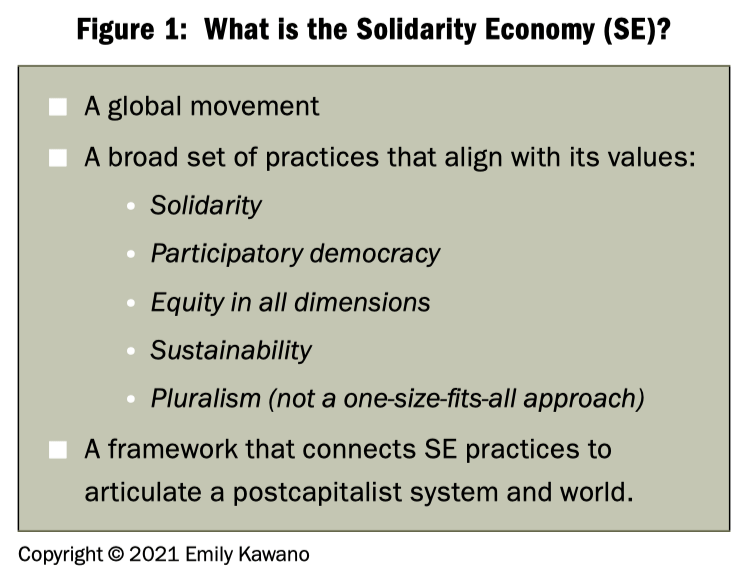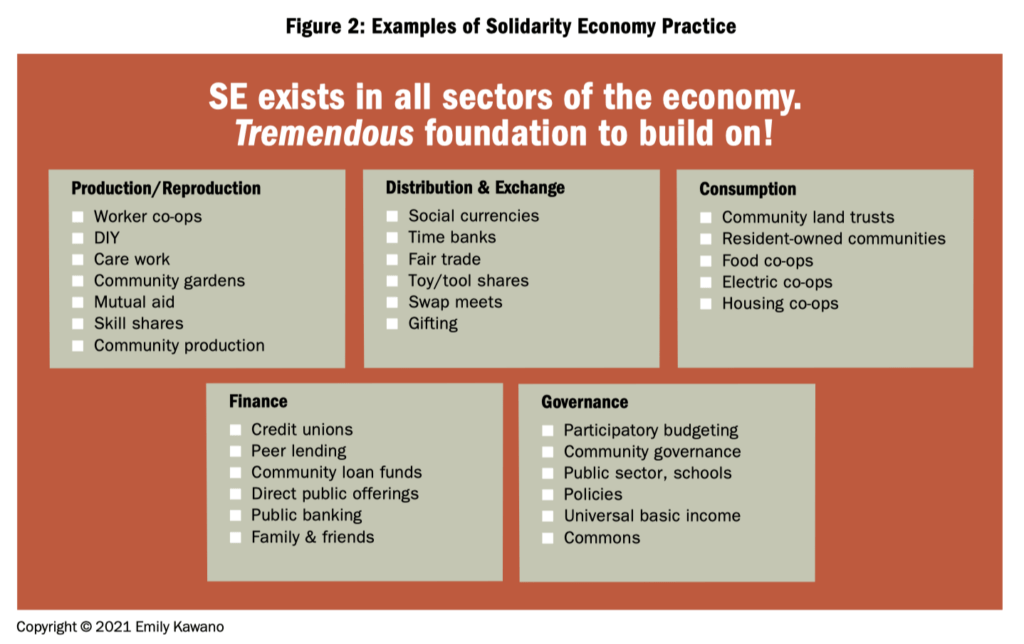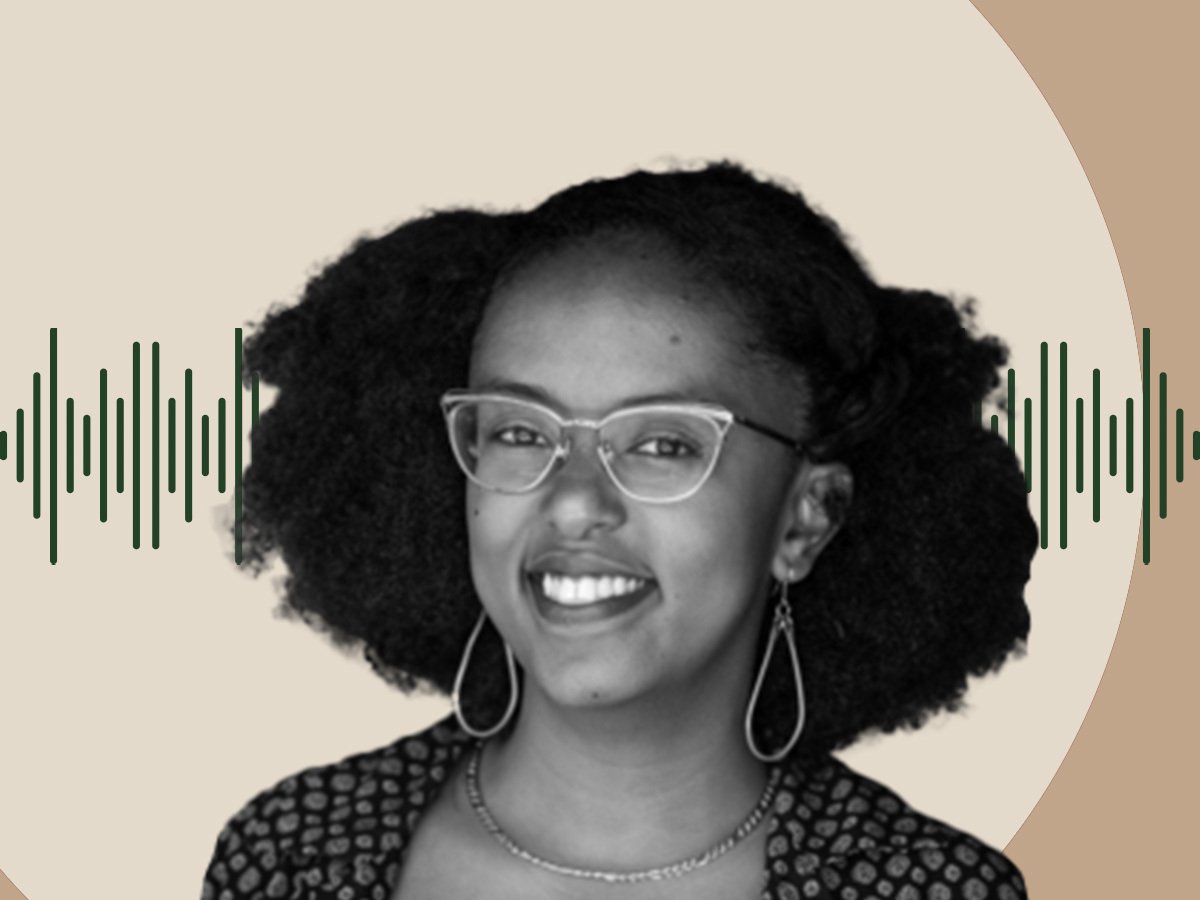
Click here to download this article as it appears in the magazine, with accompanying artwork.
This article comes from the Summer 2021 edition of the Nonprofit Quarterly, “The World We Want: In Search of New Economic Paradigms.”
The discovery of imaginal cells, or discs, goes back to the 1600s, but the metaphor of imaginal cells was popularized by Norie Huddle in her 1990 book Butterfly. The story of a butterfly’s metamorphosis provides a lovely and useful metaphor for the metamorphosis from a system of capitalism to a postcapitalist system: the solidarity economy (SE).
Awakening to a Different Vision
When a caterpillar spins its chrysalis around itself, a magical process begins. First, its body starts to break down into a nutrient-rich goop. Within this goop are imaginal cells, which were present all along within the caterpillar but had been dormant. These imaginal cells begin to express a genome inherited through evolution, a genome that is different from that of the caterpillar.1
These imaginal cells, in other words, have a different vision of what they can become. They are so different, in fact, that what remains of the caterpillar’s immune system views them as foreign interlopers, and attacks and destroys them.
Common Vision and Clustering
Yet, surviving imaginal cells begin to recognize each other as having a common purpose and vision of becoming. They begin to cluster together, and are able to fend off the attacks of the immune system. More and more of the imaginal cells find each other, come together, and survive. The surviving clusters find other clusters, and continue to come together.
Cooperation, Integration, Emergence
As the imaginal cells continue to coalesce, they start to specialize into their preprogrammed expression. Some develop as an eye, some grow into a leg, some become the body, and some the wing. These pieces work together, each integrating with the others, until what emerges from the chrysalis is an entirely different creature—a butterfly.2
WHAT IS THE SOLIDARITY ECONOMY?
The solidarity economy (SE) is a big tent that embraces many coexisting visions of democratic, postcapitalist economic systems. The framework, which emerged in Latin America and Europe in the 1990s, rejects state-dominated authoritarian forms of socialism, instead affirming a core commitment to participatory democracy. Furthermore, it is explicitly feminist, antiracist, and ecological, and advocates for economic transformation that transcends all forms of oppression, not just class. In contrast to the narrow self-interest, competition, and struggle to dominate others that are at the heart of racist, patriarchal capitalism, the solidarity economy is centered on a culture of solidarity, mutuality, caring, and cooperation, including social responsibility, economic human rights, and the rights of Mother Earth. SE institutions include cooperatives (worker-owned, consumer, producer), public banks, community land trusts, alternative currencies, and time banks.

In 2013, the U.S. Solidarity Economy Network (USSEN) and RIPESS, an international solidarity economy network, led a two-year international consultation process to build a shared understanding of the framework.3 While there is a tremendous latitude within the solidarity economy to encompass a wide range of approaches grounded in the local realities of culture, language, history, political-social-economic contexts, and environment, there are elements of the definition that apply across these specificities:
- The solidarity economy is a framework.
- This framework connects solidarity economy practices.
- SE practices are aligned with SE values:
- Solidarity;
- Participatory democracy;
- Equity in all dimensions—race, class, gender, abilities, etc.;
- Sustainability;
- Pluralism, meaning that this is not a one-size-fits-all approach—or, as the Zapatistas say, it’s “a world in which many worlds fit.”
- All of these elements articulate a postcapitalist vision. SE holds that we cannot achieve the just, sustainable, democratic, and cooperative world that we seek by reforming capitalism. We do not reject reforms, but we do insist on the importance of seeing them as part of a long-term process of fundamental systems change. In the absence of this, reforms end up strengthening capitalism.
- SE is an international movement that includes: RIPESS, an international solidarity economy network of continental networks; the ILO (International Labour Organization), which runs an annual Social and Solidarity Economy Academy; the United Nations, which has a task force on the solidarity economy (the UN Inter-Agency Task Force on Social and Solidarity Economy—or UNTFSSE); Bolivia and Ecuador, countries that include the solidarity economy in their constitutions; and a number of other countries that have national policy frameworks that support the solidarity economy.
AWAKENING THE SLUMBERING POTENTIAL OF A SOLIDARITY ECONOMY
The rich foundation of solidarity economy practices are like imaginal cells. Currently, they are in the equivalent of a dormant stage within the caterpillar of capitalism. However, the convergent crises of the pandemic, climate change, the racism and violence that have sparked the widespread racial justice uprisings, the economic divide, and the alarming slide toward fascism also create opportunity. People’s faith in the status quo is shaken. There’s a growing openness to new narratives, new models, and new paradigms. In this context, many of the solidarity economy’s imaginal cells are shaking off their dormancy, awakening to a different vision of becoming.
What will it take for the solidarity economy’s imaginal cells to complete the metamorphosis into a postcapitalist system that operates with a different set of values and logic? We do not need to “wait for the revolution,” because SE practices already exist all around us today. Our task is to make these practices visible, and to grow and connect them. Like the imaginal cells, we can think of three phases: (1) awakening to a different vision; (2) recognizing others as sharing a common vision, and clustering; and (3) cooperating, integrating, and emerging.

Sign up for our free newsletters
Subscribe to NPQ's newsletters to have our top stories delivered directly to your inbox.
By signing up, you agree to our privacy policy and terms of use, and to receive messages from NPQ and our partners.
1. Awakening to a different vision
It is safe to say that the great majority of the people putting into practice the principles listed in Figure 2 do not see themselves as part of a transformative process to build a more just, democratic, and sustainable world beyond capitalism. So how is it that they can be claimed as being part of a solidarity economy?
My view is that we can identify economic practices that align with solidarity economy values—even if imperfectly, and even if these practices and practitioners do not identify with the solidarity economy—in the same way that early capitalists in the seventeenth through nineteenth centuries didn’t identify as capitalists or with capitalism, since the term didn’t even emerge until the late 1800s or early 1900s.4 Adam Smith’s Wealth of Nations, published in 1776 and widely considered to be a foundational treatise on capitalism, never mentions the term.
Does this mean that the solidarity economy can grow without a self-conscious identification with the framework and vision? Not exactly. I believe we need at least a critical mass across different sectors to self-identify with the solidarity economy, in order to build beyond the siloed activities that we are currently observing.
Many of these solidarity economy practices have existed in different guises and to a greater or lesser extent throughout the course of human history. These practices have persisted despite the tendency of capitalism to marginalize or co-opt them. So, the mere existence of SE practices does not in and of itself lead to system change. Just as the seeds of the imaginal cells lie dormant within the caterpillar, it is only when their self-identification as a different creature is triggered that they are able to start finding each other, coming together, cooperating, and integrating to emerge as a butterfly.
2. Recognizing others as sharing a common vision, and clustering
Once there is self-identification with the solidarity economy, it becomes relatively easy to recognize SE practices in other sectors. This facilitates clustering, which allows for practical/mutually beneficial partnerships. There are many examples of limited clustering between two or three SE practices—for example:
- In Seattle, demands to defund the police combined with participatory budgeting. The city allocated “$30 million to a participatory budgeting process that will give [community members] a say in how the money should be used. Twelve million dollars was directly diverted from the Seattle Police Department, while the remaining $18 million comes from the Mayor’s Communities Initiative Fund.”5
- Municipal public sector support for community land trusts (CLTs) serves to increase the supply of permanently affordable housing. The City–CLT Partnership: Municipal Support for Community Land Trusts, a report by John Emmeus Davis and Rick Jacobus on CLT–municipal partnerships, cites three dozen examples of cities providing support through funding, technical assistance, donation of property, staffing, helping with regulatory hurdles, and so forth.6
- Some connections are deliberately built to meet a need, as in the case of cooperative loan funds. In fact, the sixth cooperative principle, “cooperation among cooperatives,”7 encourages connecting, but a solidarity economy framework would extend beyond the co-op sphere.
3. Cooperating, integrating, and emerging
There is enormous untapped potential to activate dormant imaginal cells of the solidarity economy.
So, we can see that the imaginal cells of the solidarity economy are already clustering, but what will it take to get to the next stage of creating the connections between existing and emergent SE elements and giving birth to a new postcapitalist system? In the United States, there are emerging efforts to build local SE ecosystems through cooperating and integrating. For example:
- Cooperation Jackson in Jackson, Mississippi, is intentionally building a solidarity economy ecosystem with interconnected elements, including a Community Production Center that uses cutting-edge technology such as three-dimensional printers and other forms of digital fabrication. It has also formed a community land trust, which holds a considerable amount of land for affordable housing and farming, and which also serves to preserve important historical sites of civil rights and Black liberation struggles. A community center provides space for gathering, community education and training, and child care. And it is working on purchasing a shopping plaza for a food co-op and other co-op businesses. This “build” work is joined up with grassroots and cultural organizing, as well as political/electoral strategies that are an example of the Resist and Build approach to integrating these strands of work. (See “Organizing the Solidarity Economy: A Story of Network Building amid COVID-19,” p. 56.8)
- Other examples of local efforts to build the solidarity economy ecosystem include: Cooperation Humboldt, Eureka, California; Solidarity Economy Initiative, Massachusetts; Boston Ujima Project; CEANYC (Cooperative Economic Alliance of New York City); and MASEN (Massachusetts Solidarity Economy Network), the first statewide SE network in the United States.
WAYS FORWARD
There are a number of sectors, some quite sizable, that in general are quite distant from self-identifying with the solidarity economy and the principles upon which it was founded. But there is enormous untapped potential to activate dormant imaginal cells of the solidarity economy—for example:
- Electric co-ops: In the 1930s, most rural areas lacked electricity, because private utilities did not find it profitable to deliver power to these areas. The Rural Electrification Administration was created to support the development of electric cooperatives to bring power to rural areas. Today, there are more than nine hundred electric cooperatives serving forty-two million people and covering seventy-five percent of the land mass of the country.9 Although they are owned by the members they serve, there are complaints that some of them operate in a way that is not transparent, democratic, or aligned with the interests of their members. “‘Most electric co-ops are boys’ clubs that re-elect the same people, that develop policies that favor their children or their buddies,’ says Tom ‘Smitty’ Smith of the consumer rights advocacy nonprofit Public Citizen.”10 Cooperative members are fighting back, educating members about their rights, encouraging members to challenge the old boys’ network by running for board seats, and creating report cards to hold the boards accountable.11 Southern Echo, in Mississippi, and Appalachian Voices are working to address overcompensation for board members who receive such payments as $50,000 a year for attending a couple of meetings a month, and office staff who, for one example, earn $180,000 a year, in areas where the median income is $20,000 to $25,000.12
- Agriculture co-ops: The Grange is the oldest agricultural organization in the United States. Established in 1867, the Grange grew out of a populist movement of small farmers who fought against cattle barons and against banks and railroad monopolies, railed against corporate domination of the government, and supported farming cooperatives.13 The modern-day Grange operates in 2,100 communities in thirty-seven states.14 The National Grange has in some ways lost touch with its roots, siding with big agribusiness and resisting the shift among its younger members toward sustainable, organic, and non-GMO farming. Numerous Granges are shutting down as their members age and their numbers dwindle. And a fierce battle has erupted in California between the National Grange and the local and state Granges:
The entrenched powers fear that if the California Grange vision infects the other states, they will no longer be able to maintain power and control. They won’t be able to lead, because they lack the expertise and the progressive populism that the new relevancy demands.… Young people don’t want to join an organization that is run by a Good Ol’ Boy Network.15
The conflict is not over. A number of lawsuits and counter lawsuits are being fought out in court, but there are lessons here about the potential for new and younger members to disrupt the old boys’ network and push an organization to rediscover its radical roots.
OTHER STRATEGIES TO AWAKEN DORMANT IMAGINAL CELLS
What are other strategies that could motivate dormant imaginal cells to embrace a transformative vision?
- Narrative shifting: Mainstream a new narrative of our economy through a wide array of media, including articles, videos, podcasts, workshops, social media, memes, events, celebrations, word of mouth, and so forth. In 2007, when the U.S. Solidarity Economy Network formed at the U.S. Social Forum in Atlanta, Georgia, the term was virtually unknown in the United States. Now, it is increasingly moving into the mainstream, and there is a thirst to learn more, as reflected in over one thousand registrations for an online SE 101 workshop in 2021.16 The Resist & Build SE Narrative group meets every two weeks to leverage this historic opening to push a narrative shift. (See “Organizing the Solidarity Economy: A Story of Network Building amid COVID-19,” p. 56.17)
- Sectoral education and engagement building: It is important to directly engage different sectors of the solidarity economy. For some sectors, it is relatively easy to advance identification with the solidarity economy. For example, USSEN’s board includes, or has included, key sympathetic national associations representing sectors such as the U.S. Federation of Worker Cooperatives, the National Federation of Community Development Credit Unions (now, Inclusiv), the National Community Land Trust Network (now GroundWorks), the Rural Coalition, and Shareable. These sectoral organizations have the ability to message their members and encourage engagement. The foundation world is starting to pay attention to the solidarity economy, as evidenced by the arts and solidarity economy report commissioned by Grantmakers in the Arts.18 (And see “The Art Worlds We Want: Solidarity Art Economies,” p. 72.19)
- Power building: This historic moment has crystallized demands for racial, social, and environmental justice. Solidarity economy, with its core values of equity, democracy, sustainability, and solidarity, is well aligned with these demands. Building solidarity economy practices centering antiracism, anti-oppression, and sustainability is a form of building power. At the same time, we are doubling down on the need to create strong relationships with social movements led by those most affected by systemic oppression; political and policy strategies; and a cultural shift toward solidarity economy values. We use the concept of “resist and build” to encompass these interrelated spheres.
…
While there is still much more that needs to be done to achieve systemic clustering of SE’s imaginal cells, we are seeing the emergence via metamorphosis of a solidarity economy.
The convergence of the multiple crises that we are facing today has created a rare opportunity to push for a new system beyond capitalism. There is a solid foundation of imaginal cells that already exist within the current system, and new ones are emerging all the time. Many already see themselves as part of a transformational process. These cells are increasingly connecting with each other and in some cases beginning to build explicit solidarity economy ecosystems. While there is still much more that needs to be done to achieve systemic clustering of SE’s imaginal cells, we are seeing the emergence via metamorphosis of a solidarity economy.
Notes
- Lynn Margulis and Dorion Sagan, Acquiring Genomes: A Theory of the Origins of Species (New York: Basic Books, 2003).
- Ferris Jabr, “How Does a Caterpillar Turn into a Butterfly?,” Scientific American, August 10, 2012.
- See Global Vision for a Social Solidarity Economy: Convergences and Differences in Concepts, Definitions and Frameworks (RIPESS, February 2015). In 2012, the RIPESS board decided to make the RIPESS Global Vision a main theme of the fifth meeting of the SSE, which was held in Manila, in October 2013. We organized a global consultation process in which an earlier draft of this paper was widely circulated, and each continent took on the responsibility of moving the dialogue through a mixture of live meetings, conference calls, and electronic communication. There was also an electronic forum on the RIPESS website that was open for comments from anyone globally. At the Manila meeting, around 100 people participated in a lively and productive World Café exercise to further explore and share their views on the meaning of the SSE. This paper builds on the whole of this process, as well as the RIPESS charter that was adopted in 2008, which lays out our values, mission, and vision.
- Fernand Braudel states, “The initial use of the term ‘capitalism’ in its modern sense is attributed to Louis Blanc in 1850.” Fernand Braudel, Civilization and Capitalism, 15th-18th Century, Vol. II: The Wheels of Commerce, trans. Siân Reynold (Oakland, CA: University of California Press, 1992).
- Manjeet Kaur, “Seattle Cut Its Police Budget. Now the Public Will Decide How to Spend the Money,” The Appeal, January 28, 2021.
- John Emmeus Davis and Rick Jacobus, The City–CLT Partnership: Municipal Support for Community Land Trusts (Cambridge, MA: Lincoln Institute of Land Policy, 2008).
- “The 7 Cooperative Principles,” National Cooperative Business Association, CLUSA, accessed May 16, 2021.
- Steve Dubb, “Organizing the Solidarity Economy: A Story of Network Building amid COVID-19,” Nonprofit Quarterly 28, no. 2 (Summer 2021).
- “Rural Electric Cooperatives (RECs),” Co-opLaw, accessed May 16, 2021.
- Matt Grimley, “Just How Democratic are Rural Electric Cooperatives?,” Institute for Local Self-Reliance, January 13, 2016.
- John Farrell, Matt Grimley, and Nick Stumo-Langer, “Report: Re-Member-ing the Electric Cooperative,” Institute for Local Self-Reliance, March 29, 2016.
- Bri Knisley, Benita Wells, and Holmes Hummel, “Power to the People: Organizing Rural Electric Cooperatives,” The Forge, October 19, 2020.
- Peter Lamborn Wilson, “Grange Appeal,” Fifth Estate 360 (Spring 2003).
- Robert Longley, “The Granger Laws and the Granger Movement,” History & Culture, ThoughtCo., December 4, 2020.
- John Collins, “West Coast Grange Wars: A Reborn Farmers’ Movement Takes on Corporate Agriculture,” In These Times, June 14, 2015.
- Solidarity Economy 101 Online workshop, January 30, 2021, hosted by the US Solidarity Economy Network and facilitated by David Ferris, Emily Kawano, and Mike Strode.
- Dubb, “Organizing the Solidarity Economy.”
- Nati Linares and Caroline Woolard, Solidarity Not Charity: Arts & Culture Grantmaking in the Solidarity Economy (New York: Grantmakers in the Arts, March 2021).
- Nati Linares and Caroline Woolard, “The Art Worlds We Want: Solidarity Art Economies,” Nonprofit Quarterly 28, no. 2 (Summer 2021).













